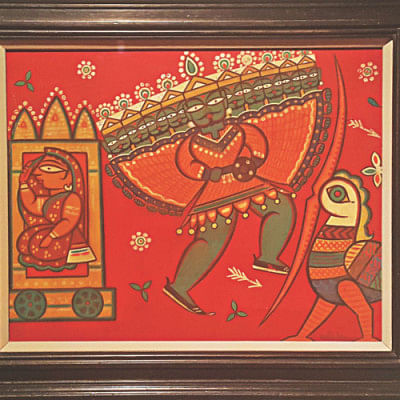Kumar's Jamini: A Class Apart

Sheltered by the snow-capped Swiss mountains, the picturesque city of Lugano sits demurely next to Lake Lugano with intermittent sunny mornings gracing the city with a magical air. Such a delightful backdrop aptly calls out to art connoisseurs, welcoming them to an unprecedented art exhibition -- of more than seventy essential art pieces of the herald of modern Indian art: the maestro Jamini Roy, at the Museum delle Culture.
The exhibition is titled “Jamini Roy: From Tradition to Modernity”, a Kumar Collection. The eponymous Dr. Nirmalya Kumar, despite being a faculty of the London Business School and a member of the group executive council of Tata Sons, is an avid collector of Roy's artwork. His love for these art pieces have evolved over 15 years, ever since he first laid eyes on “Seated Lady” for the first time. With utmost care, Kumar has been collecting and preserving Roy's masterpieces, and now the world gets to revel in them as well- in their first exhibition in Europe.
Roy's works come alive through interplay of parallel lines, solid colours, folk motifs; the purity and simplicity of his technique making them a class apart. It is easy to see why his work has been praised highly by renowned art critics, who have compared him to the likes of Matisse.
Walking through the museum, I could feel the presence of the artist through the colours, motifs, and shapely eyes of the women, cats and children in his paintings, and particularly through the bold lines. Synthesis, balance and shape - all three ingredients are predominant in Roy's work. From the very first displayed painting of blue figure with parrot to casa, from a santal girl (the flower) to Nude lady, from bankura horse to cat and catfish, from Tagore to Christ - all depict diverse styles such as Kalighat, Impressionism and Christian art (Pink Phase). The geometric patterns of the figures depict the mathematical intellect of the artist, whose visual images are not just representing a culture but also the essence of his individual attitude towards visual art.
I was deeply moved to see the vividness of his artistic expressions; some drawings were just about lines while few of them too detailed (abduction of Sita, Krishna and Blarama, Musicians) to describe.
When one observes his cat series, one notices that symmetry in shape, size and color has been used to create harmony between two cats in conflict. An amazing balance can be witnessed in any Jamini Roy piece. The distribution of color in any surface is flat and from pink to monotone we see the same treatment, despite usage of a few grades. Using traditional motif is another attractive attribute of Roy's works. 'Alpona' motifs are well used on his surfaces. All the elements in the artworks comes alive, vividly representing Bengali culture which Roy knew so well.
He was influenced deeply by expressionism; many will marvel at some works which were completed through simple brush strokes. The Tagore portrait and Nude Lady are indubitably an absolute image of modern expressionism. Through these art pieces, it is easy to understand that Roy, although solely traditional by skill and medium, was fully devoted to modern representation.
Although their original resting place is a sprawling apartment in Baker Street, the artworks seem to come alive in their temporary residence in the chillier European climes of Lugano. How is it that these Indian Modern Art pieces have transcended geographic and time boundaries to reach out to aficionados of such different heritage? It is a testament to the universality of Jamini Roy's work.
The role of an art collector is similar to that of a safe-keeper of a component of heritage and art history. A truly successful art collect does not merely “collect” art; he also acts as an emissary presenting the artist's collection for the whole world to partake in, to bask in their glory. As a collector, Kumar has achieved this. He has made himself one with Roy's work, going so far as to say: “I didn't choose Jamini Roy. He chose me.”
While leaving the venue, I was thinking how he would now stay at his house with empty walls. But then I realise his Rabindranath Tagore, MF Husain, FN Souza and Ganesh Pyne works help to bear sacrificing his Roys for a few days just a bit easier!
The writer is a visual artist.

 For all latest news, follow The Daily Star's Google News channel.
For all latest news, follow The Daily Star's Google News channel. 



Comments